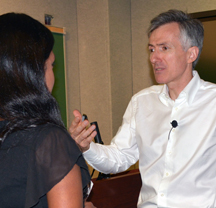Developing the Gentle Art of Persuasion
By Cindy Brauer
The ability to influence an individual, group or situational outcome is a potent, but gentle art, according to communications expert Jean-luc Doumont, who spoke at a recent workshop on “The Art of Persuasion” at The Scripps Research Institute (TSRI).
In the workshop, sponsored by TSRI Career and Postdoctoral Services, the Graduate Program and the Scripps California Society of Fellows, Doumont offered what he considers a framework for developing persuasive skills. “We influence people and are influenced by people all the time; we should understand the process and use it effectively ourselves,” he said.
In an animated presentation peppered with examples from his personal and professional experiences, particularly in academic institutions, Doumont elaborated on two factors he believes are essential to effective persuasion: power and tactics.
Personal and Organizational Power
“Power stems from who we are, both as a person (personal power) and as a member of an organized structure (organizational power),” he explained.
According to Doumont, personal power stems from knowledge, skills, charisma and attitude, expressed both verbally and nonverbally. Organizational power is based on a person’s role in relation to an organization and its associated resources—money, people, information, etc.
Power is communicated through self-confidence, presence and sincerity, said Doumont. Confidence bestows credibility and is enhanced with physical behaviors such as a stable stance, poised voice (slow and deep) and sharp, deliberate gestures.
An effective presence can be promoted through physical positioning—close to and preferably higher than the audience with steady eye contact.
Sincerity matches the spoken word with the visual and vocal cues of body language. “Sincerity goes a long way toward convincing others,” Doumont emphasized. “It’s easy to lie with words, not so easy with the body. Speakers who put on a [false] appearance antagonize the audience.”
Four Tactical Fronts
Persuasive tactics fall into four “planes” of interaction: intellectual, material, idealistic and emotional, said Doumont.
To appeal to others on an intellectual plane, state politely, but specifically, what is desired. Appeal to logic and authority.
To use an idealistic plane, appeal to values. Be a role model, an example to follow.
To work on a material level, negotiate, compromise or exchange favors.
Finally, to operate on an emotional plane, appeal to friendship, ask for help. Request advice to involve the other. Integrate socially by developing empathy.
“Tactics often must be subtle to be successful,” Doumont said. “Identify which planes you operate on personally and those you use to persuade. Try to work on each plane.”
These tactics work, he contends, because they are linked to behavior-motivators that have evolved for the survival of individuals in a social group, including:
- Reciprocity – “If I do something for you, you’ll likely feel indebted to me and more willing to accept my request.”
- Consistency – “You will be more likely to ‘buy in’ to a request that makes you appear self-consistent” in public statements, behaviors or commitments.
- Validation – “You will be more likely to accept a request if you know or I tell you that others have accepted it.”
- Liking – “You will more willingly accept a request from me if you like me.”
- Response to scarcity – “You will more likely grant a request if the object, information or opportunities seem limited, scarce, or unique.”
In conclusion, Doumont reminded the audience to remain receptive to others. “Power belongs to those who ask questions. Listen attentively. Build on what you hear. Don’t be afraid of any answer. It tells you where to start.”
Send comments to: press[at]scripps.edu














